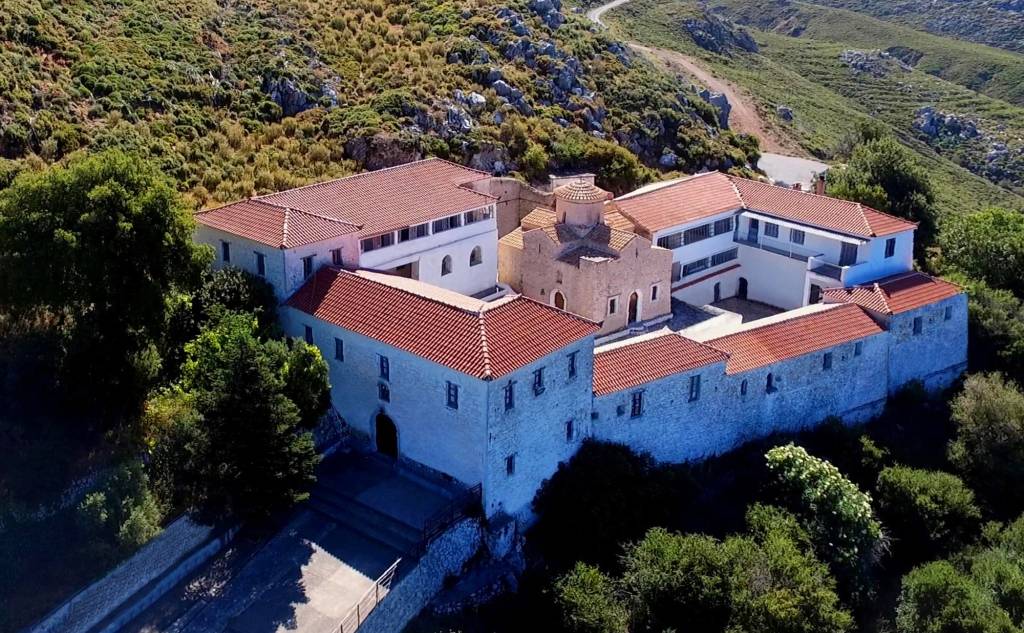Dimiova's Monastery

The Monastery of Dimiova, (Monastery of the Assumption of the Virgin Mary), is built at an altitude of 785 meters, in the trees. It is located 15 km from Kalamata, above Eleochori, (Giannitsa). The monastery is often referred to as Dimiova, Timiova and Dimonovo. Its name is of Slavic origin and means "crocotopi" where the crocus plant blooms. Even today this plant grows in the forest around the Monastery. The complex is four-sided and resembles a fortress, as it is surrounded by high cells and auxiliary spaces. Remarkable is the ruined " Rigas’ Tower", in the southwest, outside the precinct.
The Monastery of Dimovas celebrates on the 15th of August, while on September 3rd the procession of the icon of Panagia Dimitovitissa is special, which starts at 12 noon from the Monastery and ends (after a 13 km hike), at the church of the Genesis of the Virgin in Giannitsanika. There, the icon remains for ten days and then returns to the Monastery. The first descent of the image took place in the spring of 1843 to "liberate" the world from diseases and epidemics. The miraculous icon of Panagia Eleousa, named "Hope of Christians", dates back to the 16th or early 17th century. In fact, it has a wound with dried blood on the Virgin’s head that came from a blow with a sharp object. Legend has it that this blow was inflicted by the Byzantine emperor Leo Isaurus’ brother during the Iconoclasm. The icon was returned to the church of the Monastery in 1837 when its main damages were restored.
The Monastery of Dimiova existed, at least, from the 15th century, as we know that its cells were set on fire by the Turks in 1463 (during the Venetian-Turkish war), and was destroyed in 1770 by the Turks in retaliation for the "Orlov Revolt", (the failed revolution of the Greeks by the Russian officers Theodoros and Alexios Orloff). Its current form dates back to the early 17th century. During the Revolution of 1821, the Monastery of Dimiova, as well as the monastery of Mardaki, were a refuge for the chieftains of the area and their men. The monastery was taken apart in 1834, during the Reign of Maurer, removing all the sacred utensils, sacred vestments and offerings. In 1837, during Otto's reign, under pressure from the inhabitants, it was renovated and reopened. Until 1944 it was a monastery and from 1960, it was transformed into an abbey. During the German occupation, the Abbot of the Monastery and the monks abandoned it for personal safety reasons. During the years 1968-1969, a radical renovation of the Monastery was made by the Metropolitan of Messinia Chrysostomos Themelis. Finally, the Monastery had suffered serious damage during the earthquake of Kalamata, in 1986, and was restored by the Archaeological Service.
The Katholikon, (dedicated to the Assumption of the Virgin Mary), is a square cruciform inscribed church without a narthex, with a dome supported by two columns. The dome has a cylindrical drum. A four-sided bell tower rises in the northwest corner of the church. Internally, it is decorated with hagiographies painted by monk Damaskinos, in 1663, according to the inscription that survives above the entrance. The wood-carved iconostasis of the church was built in 1773 by Andreas Koronaios Anagnostis, from Mikromani and it replaced the older and damaged one after its burning in 1770.



